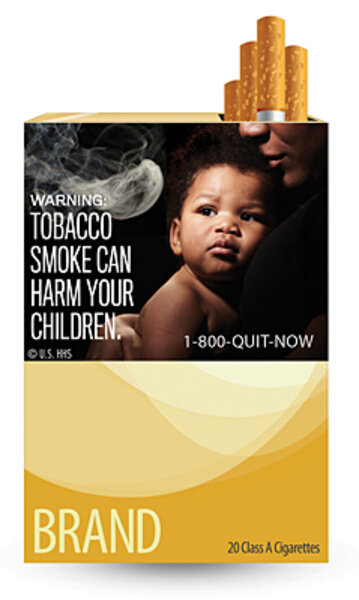Warning labels for cigarette packs take a grisly turn. Will they work?
Loading...
| New York
Announcing the first change to cigarette pack health warnings in 25 years, the US Food and Drug Administration unveiled nine graphic warning labels Tuesday that cigarette companies will be required to print by the fall of 2012 on the top half of every cigarette pack and 20 percent of every poster or ad.
Some of the images are grisly – showing the top half of a cadaver after an autopsy – and designed to perhaps shock smokers into quitting. Others are somewhat educational, showing smoke drifting toward a young child’s face with a warning that tobacco smoke can harm your children. And, every pack will contain the 800 number to call for help quitting smoking.
“This represents the most dramatic change in the history of the United States efforts to curtail smoking, because it’s the first time health warnings on smoking were selected because of effectiveness instead of political acceptability,” says Matthew Myers, president of the Campaign for Tobacco-Free Kids in Washington.
But, will it make any difference once the warnings are in place? They are supposed to be slapped on by October 2012, although tobacco companies are contesting the new regulations in court.
According to Margaret Hamburg, the commissioner of Food and Drugs, economists at the agency calculate 213,000 smokers will quit in the first year. “That does not start to calculate the number who choose not to start smoking,” says Ms. Hamburg in an interview.
Although this number represents only half of 1 percent of the 40 million smokers in the US, antismoking advocates say it could save 60,000 to 70,000 lives if the tobacco-users quit for good. “Very few actions save 70,000 lives,” says Mr. Myers.
Images chosen after consumer surveys
The nine images are the result of what Ms. Hamburg terms one of the largest consumer surveys, in which 18,000 people were asked for their impressions of the warning labels. “We collected a lot of information and I think we will see an increased awareness,” she says, “Importantly, they will discourage individuals who are not yet smokers from becoming smokers.”
Already some 43 countries have graphic warnings. However, even advocates for the images say there are no conclusive studies that show a direct correlation between the ads and individuals quitting smoking.
“In every instance, there was an increased awareness, an increased sense of the real dangers of smoking and a significantly increased motivation for quitting,” says Myers. “But, it’s very hard to measure precisely how many quit because of the addition of warning labels.”
According to an FDA public comment filing by antismoking advocates, pictorial warning labels introduced in Australia in 2006 made 57 percent of smokers think about quitting, helped 36 percent of smokers reduce their consumption, and helped 34 percent of smokers try to quit.
Old warnings lost their impact
Although US cigarette packs already contain health warnings, they have not changed in 25 years, points out Ms. Hamburg. “After 25 years we know they no longer have much impact," says Hamburg.
In order to avoid having the same thing happen to the graphic images, Hamburg says the FDA will study consumer responses, adding new images and health warnings to make sure people don’t become “inured” to the new images.
Antismoking advocates don’t expect the new images to significantly cut down on smoking unless Congress or the states fund more smoking-reduction efforts.
“The Lung Association has called attention to the need for increased funding for state quit lines so as people see these images in 2012, there is someone to answer the phone,” says Erika Sward, director of National Advocacy for the American Lung Association in Washington.
She says reducing smoking will help rein in health-care costs, which now come to $96 billion per year to treat smokers for such diseases as lung cancer and heart attacks. “A large burden of that is in the Medicaid population,” she says, referring to those who are too poor to afford health insurance.
The new images are the result of tobacco regulations passed by the Democratic controlled Congress in 2009 and supported by the Obama administration.
Six tobacco companies filed suit
Although the new images are supposed to go into effect by October of 2012, six tobacco companies sued the government in a federal district court in Kentucky in 2009 over the new law. Among their challenges, the companies claimed the new regulations interfered with their freedom of speech rights by forcing their names to appear on the bottom of the pack.
The court struck down a government ban on color and graphics on tobacco labels and a government ban on claims by tobacco companies implying that a tobacco product is safer because of FDA regulation and approval.
However, the court upheld the requirement for large graphic warnings on tobacco packages.
The decision is being appealed by the companies. The Sixth Circuit Court of Appeals in Cincinnati is scheduled to hear oral arguments on July 27.
At the hearing, the companies can ask the federal appeals court for an injunction to prevent the new rules from going into effect until the court rules, says John Banzhaf, special counsel for Action on Smoking and Health and a public interest law professor at George Washington University in Washington.
The tobacco companies "could win and the new rules would not go into effect or the litigation is more likely to delay them,” he says. He says the industry may take the case all the way to the US Supreme Court if they lose.
“That would add at least another year of delay and the whole process would certainly take more than 15 months,” he says. “The courts usually take the view of not disturbing the status quo until the case is decided, in which case an injunction is quite possible.”





